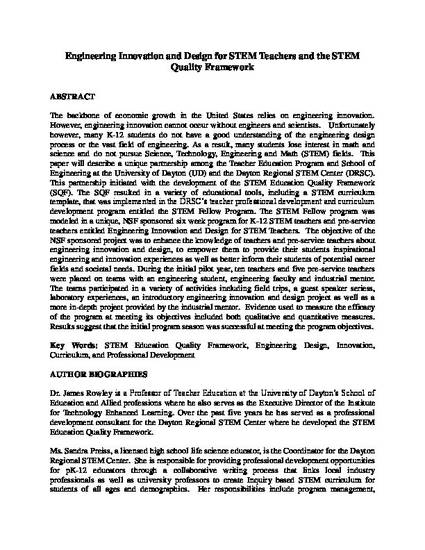
Other
Engineering Innovation and Design for STEM Teachers and the STEM Quality Framework
2nd P-12 Engineering and Design Education Research Summit
Document Type
Conference Paper
Publication Date
4-1-2012
Abstract
The backbone of economic growth in the United States relies on engineering innovation. However, engineering innovation cannot occur without engineers and scientists. Unfortunately however, many K-12 students do not have a good understanding of the engineering design process or the vast field of engineering. As a result, many students lose interest in math and science and do not pursue Science, Technology, Engineering and Math (STEM) fields. This paper will describe a unique partnership among the Teacher Education Program and School of Engineering at the University of Dayton (UD) and the Dayton Regional STEM Center (DRSC). This partnership initiated with the development of the STEM Education Quality Framework (SQF). The SQF resulted in a variety of educational tools, including a STEM curriculum template, that was implemented in the DRSC’s teacher professional development and curriculum development program entitled the STEM Fellow Program. The STEM Fellow program was modeled in a unique, NSF sponsored six week program for K-12 STEM teachers and pre-service teachers entitled Engineering Innovation and Design for STEM Teachers. The objective of the NSF sponsored project was to enhance the knowledge of teachers and pre-service teachers about engineering innovation and design, to empower them to provide their students inspirational engineering and innovation experiences as well as better inform their students of potential career fields and societal needs. During the initial pilot year, ten teachers and five pre-service teachers were placed on teams with an engineering student, engineering faculty and industrial mentor. The teams participated in a variety of activities including field trips, a guest speaker series, laboratory experiences, an introductory engineering innovation and design project as well as a more in-depth project provided by the industrial mentor. Evidence used to measure the efficacy of the program at meeting its objectives included both qualitative and quantitative measures. Results suggest that the initial program season was successful at meeting the program objectives.
Inclusive pages
1-18
Document Version
Published Version
Copyright
Copyright © 2012, P-12 Engineering and Design Education Research Summit
Publisher
P-12 Engineering and Design Education Research Summit
Place of Publication
Washington, D.C.
Disciplines
Citation Information
James Rowley, Sandi Preiss, Margaret Pinnell and Suzanne Franco. "Engineering Innovation and Design for STEM Teachers and the STEM Quality Framework" 2nd P-12 Engineering and Design Education Research Summit (2012) Available at: http://works.bepress.com/margaret_pinnell/11/

This document is provided for download by permission of the primary organizer. Permission documentation is on file.